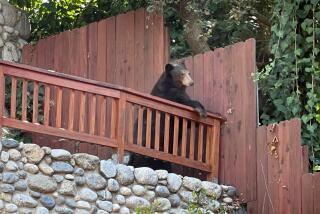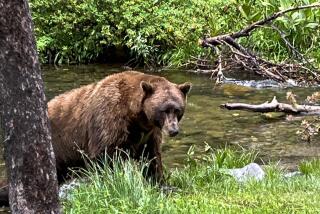Kill quota: Bull’s-eye on bears
Bear hunting in California is not a popular sport. A fraction of 1% of Californians hunts bears in the state. But it is highly regulated by the state’s Department of Fish and Game. The season runs roughly from October through December. Hunters must obtain an identification tag, make only one kill, and turn in the tag with information on where the bear was taken, along with the bear’s skull so that state authorities can determine the gender and age to monitor the population. (The skulls are returned.) Cubs as well as female bears with their young are off-limits to hunters. No more than 1,700 bears may be killed each season, and if the state reaches that quota early, the season is closed.
Now the state wants to raise the quota to 2,000. The state’s Fish and Game Commission, which approves policies that the department carries out, is scheduled to vote on the issue next week. This is the third year in a row the department has proposed expanding bear hunting in some way. The two previous proposals triggered vociferous opposition from animal welfare and environmental groups, and various politicians — and were ultimately withdrawn by the department. This year, the Humane Society of the United States has opposed the increase, and 21 California legislators have sent a letter to the commissioners urging them to reject the proposal.
One of the mandates of the Department of Fish and Game is to provide recreational activities for all of the state’s residents — whether they want to admire animals from afar or hunt them. The department contends, based on information from hunters’ tags, biologists’ field studies and anecdotal evidence, that the bear population has been trending upward for more than 30 years and that there are about 40,000 bears in the state — a robust population that can more than sustain a modest increase in the kill quota. But a conservation biologist hired by the Humane Society to evaluate the department’s proposal says that these numbers are volatile estimates and that the bigger question is how bear populations are faring region by region in the state.
Although the department has done a conscientious job of monitoring hunters and scrutinizing their kills, we think it should try to get estimates of regional bear populations before moving to increase the quota. The commission might consider adopting regional quotas for bear hunting — something it has already done with most big-game hunting, including elk, deer and bighorn sheep. Meanwhile, the state continues to allow hunters to use dogs to “hound” bears, often exhausting them or forcing them up trees. Animal welfare advocates have argued for years that this is unsportsmanlike, and cruel to the bears and dogs alike. Whether the commissioners change the quota or not, we suggest they ban the use of dogs for hunting bears.
More to Read
A cure for the common opinion
Get thought-provoking perspectives with our weekly newsletter.
You may occasionally receive promotional content from the Los Angeles Times.










